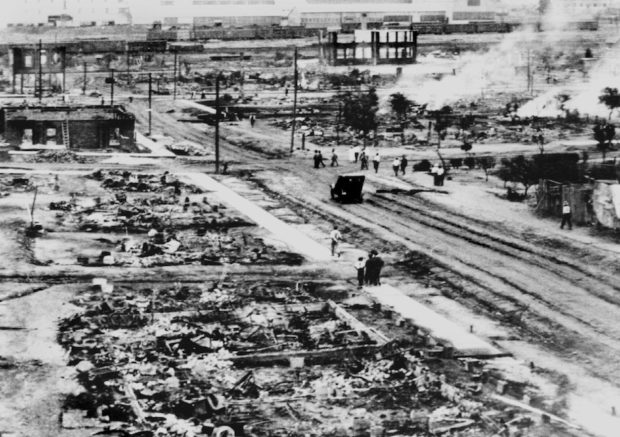It was called a “riot.” But it was really a massacre — one of the bloodiest in American history.
This material is adapted from Don’t Know Much About® History: Everything You Need to Know About American History but Never Learned (pages 325-327).
In the early 1920s, Tulsa, Oklahoma, was a boisterous postwar boom town, getting rich quick on oil that had recently been discovered there. It was a place where the postwar Ku Klux Klan recruiters found fertile grounds. The isolationist mood, or the America First movement also called nativism, was also flourishing.
In the popular mood of the country, America was white and Christian, and it was going to stay that way. On May 30, 1921, when a teen-aged Black shoe shiner was arrested for assaulting a white girl in an elevator, the publisher of the local paper—eager to win a local circulation war—published a front-page that witnesses have claimed said, “To Lynch Negro Tonight.” (No copy of the paper was ever found, even in newspaper archives.)
It was a familiar story in the Deep South of that era—a Black man accused of sexually assaulting a white woman. Soon after the paper hit the streets, white crowds began to gather outside the courthouse where the accused shoe shiner, Dick Rowland, was being held. (Rowland was eventually released when the woman did not press charges.)
Blacks from the Tulsa neighborhood of Greenwood, some of them recently discharged war veterans, also began to descend on the courthouse to protect Rowland from being lynched. Shots were fired and soon the wholesale destruction of an entire community began in hellish force. A mob of more than 10,000 whites, fully backed by the white police force, went wild. It was called a riot but it was a massacre, or in modern parlance there is a better term—“ethnic cleansing.” It lasted over three days.
As historian Tim Madigan put it in his book on Tulsa, The Burning,
“It soon became evident that whites would settle for nothing less than scorched earth. They would not be satisfied to kill negroes, or to arrest them. They would also try to destroy every vestige of black prosperity.”
Soon white women were looting Black homes, filling shopping bags. White men carrying gasoline set fire to the Greenwood neighborhood.

An overview of the aftermath of the Tulsa race massacre in 1921. (Greenwood Cultural Center) via Washington Post
When it was over, there were many dead Blacks, some of them dumped into mass graves, and their neighborhood was in cinders, with more than 1,200 homes burned. Insurance companies later refused to pay fire claims, invoking a riot exemption. To add to the crime, the story disappeared from local history. Even local newspaper files were eventually cleaned out to remove evidence of the incident.
“Tulsa Searches for Mass Graves” (Washington Post, October 23, 2019)
For decades, the massacre was hushed up, kept alive only by oral traditions of a few survivors. Only after nearly eighty years of silence did Tulsa and the Oklahoma legislature come to grips with the past. Historians looking into the city’s deadly massacre believe that close to 300 people died during the violence. In 2000, the “Tulsa Race Riot Commission,” a panel investigating the incident, recommended reparations be paid to the survivors of what is still considered the nation’s bloodiest incident of racial violence.
“No legislative action was ever taken on the recommendation, and the commission had no power to force legislation. In April 2002 a private religious charity, the Tulsa Metropolitan Ministry, paid a total of $28,000 to the survivors, a little more than $200 each, using funds raised from private donations.” (Source: Encyclopedia Britannica)